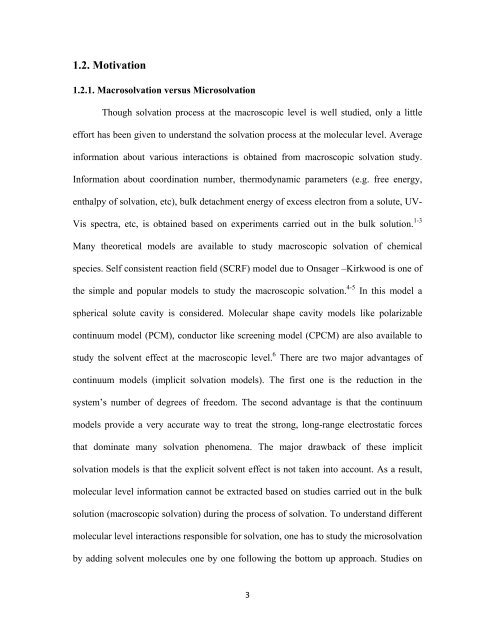CHEM01200604005 A. K. Pathak - Homi Bhabha National Institute
CHEM01200604005 A. K. Pathak - Homi Bhabha National Institute
CHEM01200604005 A. K. Pathak - Homi Bhabha National Institute
You also want an ePaper? Increase the reach of your titles
YUMPU automatically turns print PDFs into web optimized ePapers that Google loves.
1.2. Motivation<br />
1.2.1. Macrosolvation versus Microsolvation<br />
Though solvation process at the macroscopic level is well studied, only a little<br />
effort has been given to understand the solvation process at the molecular level. Average<br />
information about various interactions is obtained from macroscopic solvation study.<br />
Information about coordination number, thermodynamic parameters (e.g. free energy,<br />
enthalpy of solvation, etc), bulk detachment energy of excess electron from a solute, UV-<br />
Vis spectra, etc, is obtained based on experiments carried out in the bulk solution. 1-3<br />
Many theoretical models are available to study macroscopic solvation of chemical<br />
species. Self consistent reaction field (SCRF) model due to Onsager –Kirkwood is one of<br />
the simple and popular models to study the macroscopic solvation. 4-5 In this model a<br />
spherical solute cavity is considered. Molecular shape cavity models like polarizable<br />
continuum model (PCM), conductor like screening model (CPCM) are also available to<br />
study the solvent effect at the macroscopic level. 6 There are two major advantages of<br />
continuum models (implicit solvation models). The first one is the reduction in the<br />
system’s number of degrees of freedom. The second advantage is that the continuum<br />
models provide a very accurate way to treat the strong, long-range electrostatic forces<br />
that dominate many solvation phenomena. The major drawback of these implicit<br />
solvation models is that the explicit solvent effect is not taken into account. As a result,<br />
molecular level information cannot be extracted based on studies carried out in the bulk<br />
solution (macroscopic solvation) during the process of solvation. To understand different<br />
molecular level interactions responsible for solvation, one has to study the microsolvation<br />
by adding solvent molecules one by one following the bottom up approach. Studies on<br />
3
















